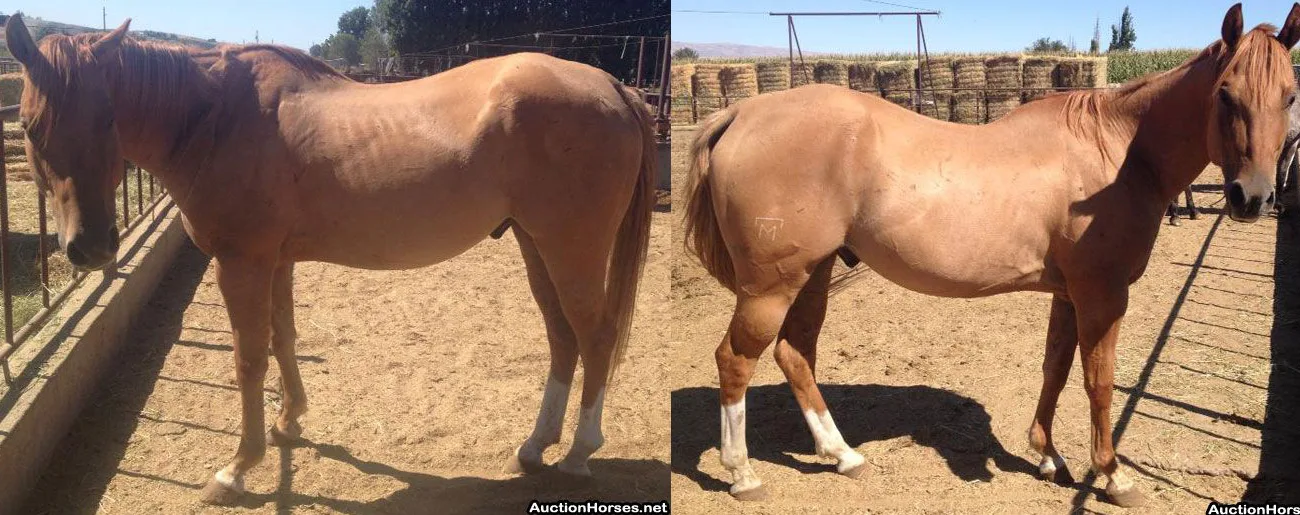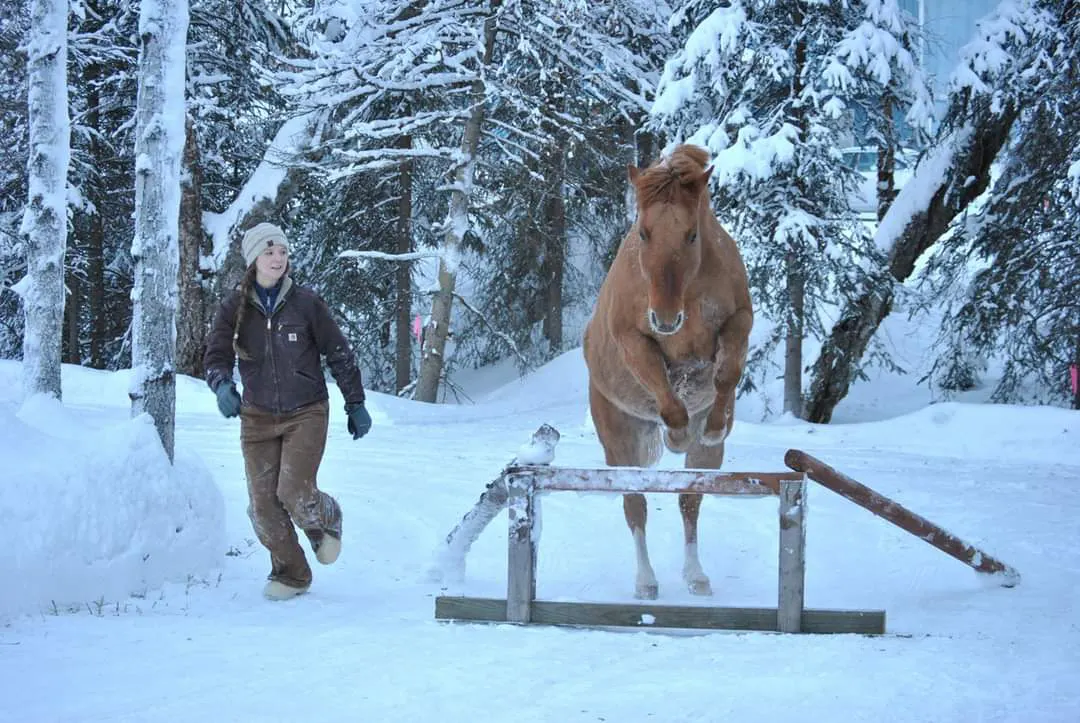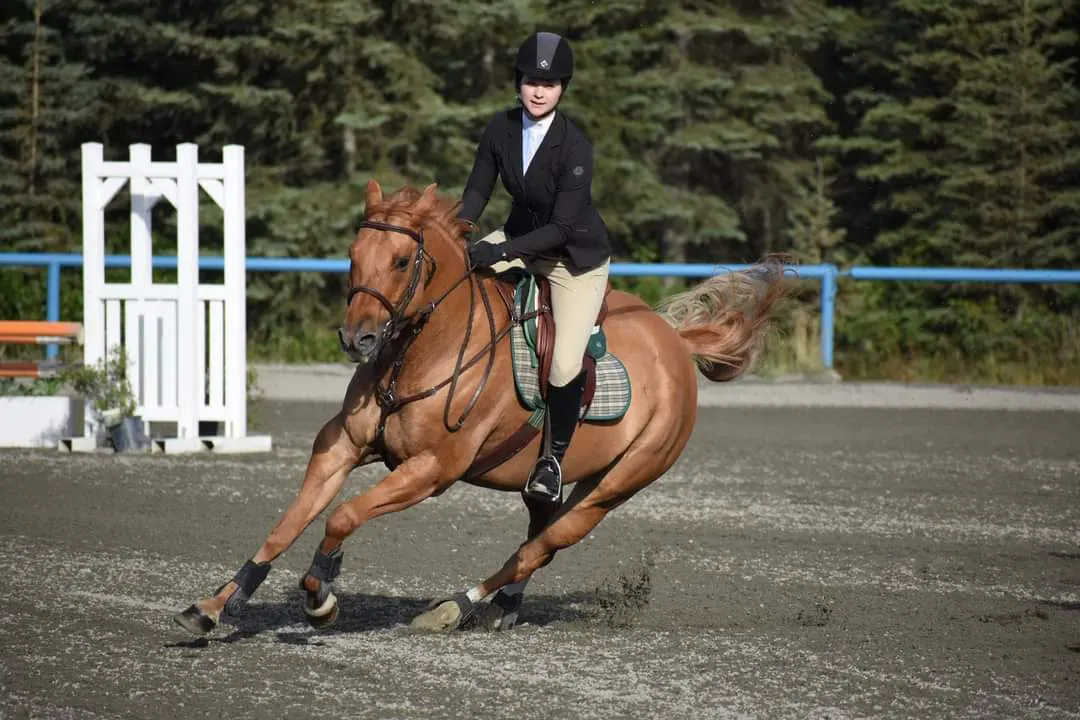In the autumn of 2014, 19-year-old Amy Brassard was casually on the search for a new horse after retiring her childhood mount. At the time, she and her elder sister Emily Parmenter were regular followers of a Facebook page called Auction Horses that showcased horses located in kill pens, feed lots and other “last chance” situations throughout the Pacific Northwest. One fateful day, Parmenter tagged her younger sister in the comments section of an Auction Horses post.
Brassard—a lifelong resident of Anchorage, Alaska—had enjoyed showing her childhood horse, Lee, on the local Quarter Horse circuit with her sister, and she was excited about the idea of being able to get back into it with a new mount. The horse in the post was clearly a Quarter Horse type, but other than an approximate age of 7 or 8, no other information was provided. However, the red dun gelding boasted a clear brand on his right quarter, and based on that, the sisters were confident they could track down his parentage and get him registered with the American Quarter Horse Association. Listed as “Sunny” in the ad, the gelding was a little thin, definitely under muscled, and had a pronounced swayback.
“The ad said it was his ‘last day to save, we’re going to the slaughterhouse in the morning,’ or something like that,” Brassard said. “In the pictures on Facebook, he didn’t look terrible, and the swayback didn’t really bother me, because I figured it was from lack of exercise and food. We had a vet go look at him, and he passed that check.”

Brassard decided to take a chance and purchased the gelding for $500, his price per pound.
However, there were a few significant hurdles yet to overcome. Perhaps most challenging: “Sunny” was located on a lot in Sunnyside, Washington, nearly 2,400 miles away from his new home at Brassard’s parents’ property in Anchorage.
“To get a horse from the Lower 48 to Alaska is complicated, but it’s also pretty common,” said Brassard, who notes that many essential equine supplies, including hay and grain, are also brought up from the mainland. “It takes about a week to haul up here, and you have to have everything in order with vaccines and health certificates in order to pass through Canada.”
The second issue was that Brassard, who at the time still lived with her parents, hadn’t told them about her new purchase. In fact, the gelding was already en route to Alaska before she broke the news, which fortunately was well received.
“They were totally fine with it,” Brassard recalled with a laugh. “My parents, Patti and Tracey Brassard, were not horsey, but when I was 12, we finally convinced them to have horses at our house. They are horse people now, though. When my sister was expecting her first child four years ago, we got a mini to tell them she was pregnant. Now, they feed him every day and take him for walks.”
As her new horse’s arrival date grew near, Amy was excited to meet him. But when the hauler was about an hour away, she called to warn Amy not to get her hopes up.
“She told me, ‘I don’t know how this horse made it, and I won’t be surprised if he drops dead when he gets off the trailer,’” Amy said. “She told me he was in rough shape and super skinny. It was nerve wracking.”
When Sunny finally arrived, Amy was confronted with “the skinniest horse she’d ever seen.” He seemed listless and dull. But she had no regrets about her decision.
“I knew I’d gotten him out of a bad situation,” she said. “I just had an overwhelming feeling that everything was going to be OK.”
The sisters are avid Disney fans, and when the hugely popular feature film “Frozen” was released the year before, they jokingly told their friends the movie was about them.
“I’m a brunette; my sister is blonde,” Amy explained. “And we live up here in frozen Alaska.”
ADVERTISEMENT
They decided to rename Amy’s new horse Sven, after the reindeer in their favorite movie.
“Sven is just Sven,” Amy said. “That’s his whole name. We were going to come up with something fancier, but Sven just stuck.”

Returning To Health
After Sven’s arrival, Amy’s first order of business was getting her own veterinarian to give him a thorough check up and help devise a refeeding program. The good news was that beyond Sven’s lack of weight, her veterinarian had no major concerns about his health, and agreed that the gelding was likely about 8 years old. But restoring Sven to good condition would take dedication and time—and plenty of forage.
“You could clearly see his shoulders, all his ribs, and that big, old swayback,” she recalled. “His withers were just a bone with a big drop on either side. But his hindquarters were the most defining thing. From his butt looking straight down his back, it just sunk in so much, and the top of his neck was really skinny.
“We worked with the vet to determine what nutrients he needed, and how to get them into him, food and mash-wise,” Amy continued. “We gave him Alaskan grass hay, some hay from Washington, a little alfalfa to bump him up, and Haystack Special Blend, which is a pelleted mix of grass hay and other nutritional supplements, to fill his belly.”
In Alaska, October is just the beginning of a long winter season, with daytime temperatures in the 40s and overnights dropping below freezing. Horses used to the climate are often only blanketed at night, and only if they really need it. But Sven’s poor body condition required that he be blanketed full time, and even then, Amy had to closely watch to make sure he didn’t get cold.

“We made sure he was warm, had all the water he needed and did a lot of handwalking to make sure he was moving,” Amy said. “My parents don’t have an indoor, and when we were kids, we rode bareback a lot just to stay warm. But Sven was in no condition to carry a rider.”
Instead, Amy spent hours bonding with Sven on the ground. She knew nothing about his background or what type of training he may have had, so she took things slowly. Over the next seven months, their relationship strengthened through unmounted activities, and she hoped it would transfer to their ridden work once Sven was healthy enough.
By the end of summer, Sven’s red dun coat shined, and his frame was at last well padded. Amy decided it was time to test him under saddle.
“The first time I did sit on him, I thought he was a completely broke horse,” Amy said. “He was so calm, just perfect.”
After riding him a few more times with similar results, Amy decided to take Sven on a trail ride along a sandy creek bed. The experience unexpectedly put their relationship to the test when Sven took off bucking, and Amy made an emergency dismount. As she watched the horse run off into the distance, she wasn’t sure how she was going to catch him.
“But we had such a strong ground connection, I just called his name, and he came running back,” she said.
The sisters’ brand research led them to Sven’s breeder in Idaho, but he was not willing to speak with them about the horse. After doing some further digging, they learned the gelding had landed at auction thanks to both his swayback and a reputation for having a hot, difficult disposition. But Amy isn’t sure how much of that she believes—especially after she learned that to the best of anyone’s knowledge, he had not been backed prior to his arrival in Alaska.
ADVERTISEMENT
“There’s just not a mean bone in his body—or at least, he’s never shown me one,” she said.
A True All-Arounder
Unfortunately, the breeder’s cold reception meant that Amy was not able to get the parentage information she would need to register Sven with the AQHA. However, she could still participate in all-breed classes held at the four shows hosted annually by the Alaska State Quarter Horse Association. Starting in 2015, Amy and Sven tried a little of everything.
“We did trail classes, western pleasure, jumped and even chased cows a few times,” she said. “I’ve even shot my bow and arrow off of him.”
In 2016, Amy connected with local hunter/jumper trainer Jaimie Thurman, and with her assistance, competed Sven in his first hunter derby. For three seasons, Amy and Sven divided their time between the ASQHA all-breed ring and open jumping classes. But Sven and Amy often found themselves the only competitors in the all-breed ring, and eventually, she decided to focus on jumping classes exclusively.
“You don’t have to be registered for that,” Amy said. “We do everything. He is really good at the jumpers; with his Quarter Horse butt, he can turn on a dime. But he also really likes the derby.”
And while Alaska may not be known for its eventing scene, in 2017, Sven tried cross-country for the first time—and loved it. Later, Amy and her sister were part of the team responsible for getting the state’s only event, the Red Mountain Horse Trials, held in the Mat-Su Valley north of Anchorage, off the ground. Amy and Sven have competed annually since the inaugural event in 2021, and she plans to enter again this year.

“We love to do the cross-country stuff now,” says Amy. “He’s become a true all-rounder.”
Now in his upper teens, Sven has more than lived up to any expectations Amy may have had for the formerly scrawny, swaybacked rescue horse she purchased sight unseen almost a decade ago. And while she is currently busy working full-time and pursuing a nursing degree, Sven is living with Thurman in Wasilla, Alaska, where he is teaching children the basics of horsemanship and taking them to their first jumping competitions. Amy makes the two-hour roundtrip drive to visit Sven whenever her schedule allows.
“Sven wasn’t a $15,000 horse,” Amy said. “He was just a diamond in the rough, and with a little love, food, and consistent work, he is now worth his weight in gold. He taught me how to be patient, because good things take time, and how to respect the healing process, both physically and emotionally, when it comes to horses. The process wasn’t the easiest, but it was by far the most rewarding. Everyone deserves a second chance.”
Do you know a horse or pony who has been rescued from a dangerous situation to become a healthy, trusted competition partner today? If you think you have a good candidate for “From Rescue To Ribbons,” let us know by emailing mwright@coth.com.














